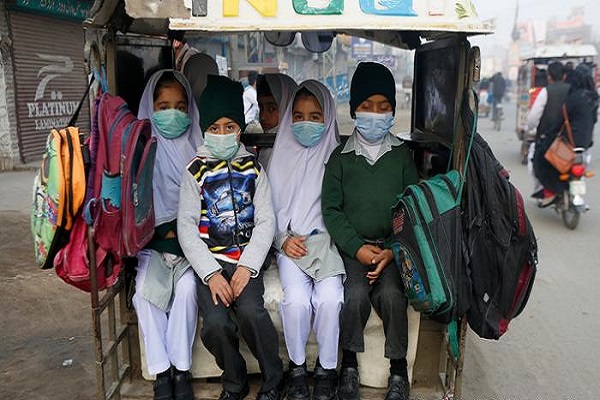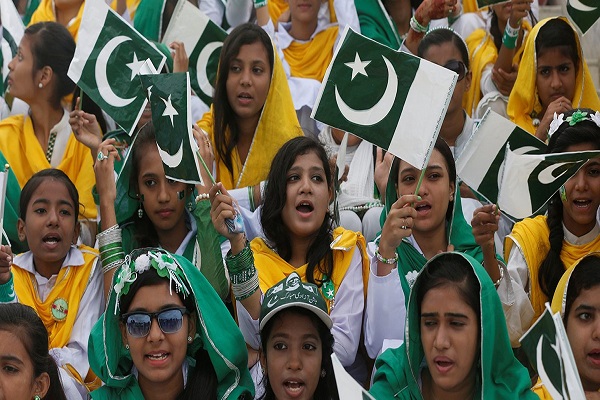Pakistan is an Islamic democratic South Asian country that came into being in the year of 1947. It is the world’s fifth populated country while the second-largest Muslim populated country. The total area of Pakistan is 881,910 square kilometers with a total population of 212 million inhabitants. The country is considered to be the 33rd largest country in the world, by area.
Islamabad is the capital of Pakistan which was transformed from Karachi due to its strategic importance. It is bordered by Afghanistan in the west, Tajikistan in the northwest, India in the east, China in the northeast while the Arabian Sea in the south. Furthermore, it has unicameral legislation and Prime Minister is the head of the state.
Pakistan is a state which came into being in the name of Muslims (Kalma -e-Tayyeba). This article has all the information including Pakistan History.
| Title | Description |
|---|---|
| Information | |
| Location: | South Asia |
| Founder: | Muhammad Ali Jinnah |
| Thinker: | Allama Iqbal |
| Pakistan Purpose Name: | Chaudhry Rehmat Ali |
| Type: | Islamic Country |
| Local Language Name: | اسلامی جمہوریہ پاکستان |
| Coordinates : | 30°N 70°E |
| Website: | www.pakistan.gov.pk |
| Government | |
| Government: | Federal Parliamentary Constitutional Republic |
| President: | Mamnoon Hussain |
| Prime Minister: | Nawaz Sharif |
| Speaker of the Assembly: | Sardar Ayaz Sadiq |
| Chairman of the Senate: | Raza Rabbani |
| Chief Justice: | Mian Saqib Nisar |
| Details | |
| Lyrics: | Hafeez Jullundhri, June 1952 |
| National Anthem: | Qaum Tarnah |
| Music: | Ahmad G. Chagla, 21 August 1949 |
| Type: | Islamic Republic of Pakistan |
| GDP: | $1.059 trillion (2017) estimate |
| Per capital: | $5,402 |
| GDP (nominal): | $270.961 billion (2015) estimate |
| Per capital: | $1,427 |
| Gini (2013): | 30.7 medium |
| HDI (2015): | Steady 0.550 medium |
| Currency: | Pakistani rupee (PKR) |
| Time zone: | PST (UTC+5b) |
| Drives on the: | left |
| Calling code: | +92 |
| ISO 3166 code: | PK |
| Internet TLD: | .pk |
| Chief Justice: | Mian Saqib Nisar |
| Legislature: | Parliament |
| Upper house: | Senate |
| Lower house: | National Assembly |
| Independence: | From the United Kingdom |
| Conception: | 29 December 1930 |
| Declaration: | 28 January 1933 |
| Resolution: | 23 March 1940 |
| Dominion: | 14 August 1947 |
| Islamic Republic: | 23 March 1956 |
| Area: | 881,913 km2 (340,509 sq mi) |
| Water (%): | 2.86 |
| Population: | 201,995,540 ( 2016) estimate |
| Density: | 244.4/km2 (633.0/sq mi) (56th) |
| Capital: | Islamabad |
| Coordinates: | 33°40′N 73°10′E |
| Largest city: | Karachi |
| Coordinates: | 24°51′36″N 67°00′36″E |
| Official languages: | Urdu, English |
| National language: | Urdu |
| Regional languages: | Punjabi, Sindhi, Pashto, Saraiki, Balochi, Kashmiri, Brahui, Shina, Balti, Khowar, Burushaski Yidgha, Dameli, Kalasha, Gawar-Bati, Domaaki |
| Ethnic groups (2016): | 44.68% Punjabis, 15.42% Pashtuns, 14.1% Sindhis, 8.38% Saraikis, 7.57% Muhajirs, 3.57% Balochis |
| Religion: | 96.4% Islam, 3.6% others |
| Demonym: | Pakistani |
| National Poet: | Allama DR. Muhammad Iqbal |
| National Animal: | Markhor |
| National Bird: | Chukar |
| National Flower: | Jasmine |
| National Tree: | Cedrus deodara |
| National Sports: | Hockey |
| Notional Dress: | Shalwar Qameez |
| National Juice: | Sugarcane Juice |
| Adopted: | 13 August 1954 |
| Composed By: | Ahmed Rushdi |
Table of Contents
Pakistan History
Alexandar Attacks
The history goes back to Alexander who came and remained here till his attack on Babylonia in 3 AD followed by the Empires of Ghaznavids, Sikhs, Mangols, Durrani, Mughals, and finally Britain in 1857. Britain accessed the subcontinent with the intentions of trade but their interest changed with time and they invaded the subcontinent.
Creation of Pakistan
Quaid -e-Azam Mohammad Ali Jinnah was the one who suggested that Muslims need a separate nation as Britain favored against Muslims and killed thousands of Muslims which resulted in the Pakistan Movement. There were a number of others who faced many hurdles in the creation including Maulana Shabir Ahmad Usmani and Sir Syed Ahmad Khan.
The Movement for the creation was started in 1910 and onwards when Jinnah joined the Muslim League which resulted in passing the Resolution of Pakistan in 1940. The British rulers were against the division of the subcontinent. The last election was held for Muslims to calculate the opinions of the public which resulted in ninety percent of Muslims’ favor in the creation of Pakistan.
Divide and Rule Policy
Finally, Britain decided to leave the subcontinent and unfairly divided it to Pakistan and India under the policy of Divide and Rule in 1947, and left Kashmir as a disputed area. Quaid -e- Azam became the first Governor-General of Pakistan but due to illness he appointed Liaquat Ali Khan as the next leader of Pakistan and died in 1948. Liaquat Ali Khan became the first Prime Minister of Pakistan.
Location
It is located in South Asia and the coordinates of the country are 33’1’30: in the north while 73’03’00” in the east.
Area
The total area is 881,910 square kilometers which makes it the 33rd largest country in the world by land.

Pakistan Population
The population of the country contains 212 million peoples which makes it the 3rd most populated country around the globe.
Languages
There are about sixty languages spoken by the people but Urdu is the official language that is spoken and understood by about seventy percent of the entire population. Other major languages are as follow:
- Punjabi – Spoken by 39 percent of the population
- Pashtu – Spoken by 18 percent of the population
- Saraiki – Spoken by 12 percent of the population
- Baluchi – Spoken by 3 percent of the population
- Other Languages – Spoken by 5 percent of the population
Religion
There are three main religions followed by the people of the country which are as follow:
- Islam – Followed by 94% of Population
- Christianity – Followed by 3% of Population
- Sikhism – Followed by 2% of Population
- Hinduism – Followed by 0.8% of Population
Provinces
Currently, there are five provinces which include:
Administration
The country is administratively subdivided into seven administrative divisions which are as follow:
- Islamabad
- Punjab
- Azad Kashmir
- Khyber Pakhtunkhwa
- Baluchistan
- Sindh
- Gilgit Baltistan

Legislation
The government of Pakistan has bicameral legislation which contains an upper house (senate) and lower house (National Assembly). Senate contains 104 members while National Assembly has 342 members, elected through general elections. Members of the Senate are elected by the legislators of provinces.
Prime Minister is considered to be the head of government who forms a cabinet for government operations that contains advisors and ministers. Prime Minister also appoints Chief Secretary for provincial operations, while the President of Pakistan appoints governors of the provinces.
Administrative Personnel
- President – Dr Arif Alvi
- Prime Minister – Imran Khan
Armed Forces
The armed forces contain military, air force, and navy. Pakistan Military is the world’s sixth-largest army and has the capability to fight with other many countries at one time. Armed forces are responsible for border safety and internal terrorism. Till 2020, Pak Army completed many successful operations against terrorism.
The Air Force is considered to be the world’s best air force. PAF contains well-trained pilots and aircraft that are capable to avoid airstrikes of the enemy. Furthermore, it has the world’s advanced jets and aircrafts such as F16 and JF 17 Thunder. Moreover, Pakistan Navy is responsible for sea–border protection and capable of fighting through advanced battle fleets.
Nuclear Power
Pakistan became a nuclear power in 1998 after testing a successful nuclear experiment. Furthermore, it is also not a part of the Nuclear Proliferation Treaty along with the other four nuclear countries which reduce the power of nuclear states.
Moreover, it has an atomic power and the world’s sixth-largest army and 1st intelligence department on world’s ranking. The motto of the country is peace, harmony, and defense are obligatory in every nation of Pakistan.

Economy
The economy is considered to be the 23rd largest economy in the world. The country had the world’s largest economy during the 1st millennium which was lost during the 18th century. However, the economy is unbalanced and the export is reducing as only 0.13 percent exports were made in the year of 2017.
Education
The constitution of Pakistan makes primary and secondary education free for the nationals of the country. It had only one university when it came into being but soon it established many public universities including the University of Peshawar, Baluchistan University, and Karachi University.
The literacy rate in the country is 63 percent which contains 72 percent of male’s literacy while 51 percent of female’s literacy.
Transport
The transport system contains:
- Roads
- Railways
- Metro
- Airlines
- Seaports
Agriculture
It is an agricultural country that has fertile land. The crops produced here are as follow:
- Wheat
- Rice
- Corn

Vegetables
Major vegetables that grown in the country are:
- Potato
- Tomato
- Chilli
- Garlic
- Onion
- Ginger
- Coriander
- Sugar been
Fruits
- Apple
- Guava
- Peach
- Banana
- Dates
- Citrus
- Pear
- Mango
- Plum
- Grapes
- Pomegranate
- Apricot
Industries
Thousands of industries are functioning excluding mining, nuclear power, hydropower, and wind power. They contribute to 20 percent of total budget of Pakistan. Some of the major industries are given below:
- Oil and Gas industries
- Power Sectors
- Textile Industries
- Cement Industries
- Automobile Industries
- Steel Mills
- Sugar Mills
- Food Industries
- Paper Industries
- Fertilizer Industries
- Oil Refinery Industries
In addition to that, it has an industrial environment and a number of all types of industries are functioning in the country. Moreover, the country has the world’s best and fertile land which produces million tons of crops each year and facilitates the economy of Pakistan.
Sports
Hockey is a national sport which is played by people all over the country and has produced many international hockey players. The hockey team participates in every world cup and league match of hockey.
Cricket is also played in the country and has a cricket team of its own who participate in every league match as well as in the world cup. The cricket team has won world cup in the year 1998 and also conduct a national cricket tournament under the name of Pakistan Super League. Other games of the country include:
- Badminton
- Volleyball
- Football
- Squash
- Wrestling
- Kabaddi
- Snooker
- Table Tennis

Tourism
There are thousands of tourist attractions among which some major tourist places are as follow:
- Khyber Pass
- Mohenjo Daro
- Hunza
- Badshahi Masjid
- Tomb of Jehangir
- Harappa
- Lahore Fort
- Lake Saif ul Muluk
- Shalimar Gardens
- Faisal Masjid
Social Media Handle
https://www.facebook.com/DailyPakistan.OfficialPage/
https://www.facebook.com/pakistanidefence/

